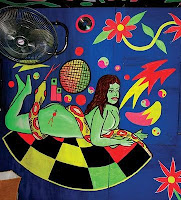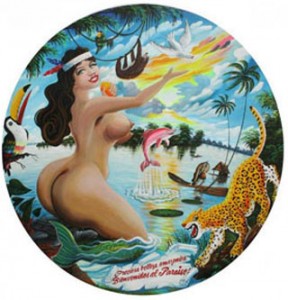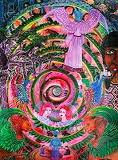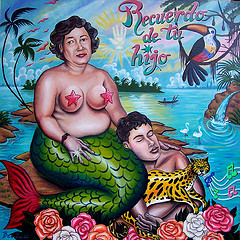The term poder verde, green power, was first applied to cumbia amazónica — the boisterous sexy ironic kick-ass garage-band party music that first developed in the Upper Amazon during the oil boom of the 1960s.
 |
| José Asunción, Huarmiboa (2007) |
Now there is an equivalent in painting — an exhibition entitled Poder Verde, Visiones Psicotropicales, Green Power: Psychotropical Visions, currently on display through April 9 at El Centro Cultural de España in Lima, which brings together the boisterous sexy ironic kick-ass visionary work of contemporary Upper Amazonian painters.
The Lima exhibit has clearly been a success. One newspaper calls it “a world vision defined by sensuality, abundance, and color.” Another says, “Opulent naked women populate several of the works of these artists, together with luxuriant fruits and wild animals that appear to enjoy the richness of the land.”
 |
| Luis Sakiray, Preciosa belleza amazónica (2006) |
And it is indeed true that this is wonderfully exuberant, extravagant, and often wryly transgressive art. Famed visionary artist Pablo Amaringo is included, of course. But also represented are the lesser known painters Harry Chávez, José Asunción Araujo, Brus Rubio, Miguel Saavedra, Jorge Cabieses, Luis Sakiray, Roldán Pinedo, and Christian Bendayán.
These artists are, for the most part, not traditional gallery artists, but rather commercial painters, muralists, folk artists, their paintings inspired by posters, advertisements, magazine illustrations, ayahuasca visions, popular symbolism, figures from Amazonian folklore and mythology. Included as well are indigenous painters — Shipibo Roldán Pinedo and Bora-Huitoto Brus Rubio — “escaping from the anthropological museums,” as the catalog puts it, so that their work can be taken seriously as art.
 |
| Pablo Amaringo, Aya-Mayuywayra (2005) |
Luis Sakiray Macuyama, for example, has been principally a muralist for Chinese restaurants, chicken shacks, and cebicherías, where his art links the succulence of the food inside to visions of curvaceous women and a bountiful landscape. José Asunción Araujo, another self-taught painter, has specialized in the decoration of Iquitos bars, nightclubs, and whorehouses.
Christian Bendayán, curator of the exhibition, said that jungle culture has always been “lively, garish, colorful, quite different from the rest of Peru, which has even looked upon it as immoral.” Surprisingly, the swirling visionary art of Pablo Amaringo appears quite at home in this company. Indeed, the exhibit takes a broad view of the visionary. “Mediated through drunkenness, sexuality, wisdom, psychotropics,” says the catalog, “the result is an aesthetic that reclaims our hallucinations, our dreams, our visions.”
 |
| Christian Bendayán, Recuerdo de tu hijo (2006) |
Fittingly, the exhibit includes performances of cumbia amazónica by groups such as Los Chapillacs, and, of course, Juaneco y su combo. Opening night featured Los Hijos de Lamas — “entertainers for weddings, funerals, divorces, and suicides.”
The catalog concludes, “It is green power, the return to roots, the snake of life that gives us these psychotropical visions, to intoxicate us with their lights and colors. Thus art and life, imagination and reason, dream and reality become one. Now we are able to see again, be again, be born again.”
The complete exhibition catalog is here.

- Previous Post: A Victory for Santo Daime
- Next Post: Handling Infections
- More Articles Related to: Books and Art, The Amazon



Green power is part of the decoration of the “Eagle’s nest”, which is the official gathering place for the friends of chuntaro club.
Hello from the Lacandon jungle!
I hope you are having a wonderful time. I want to hear all about it when you get back. There will be a big SSG welcome home breakfast for you when you return.